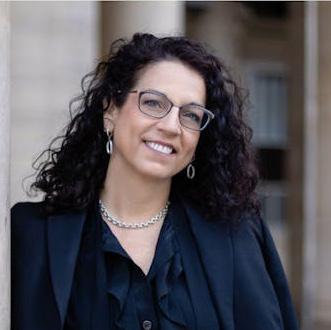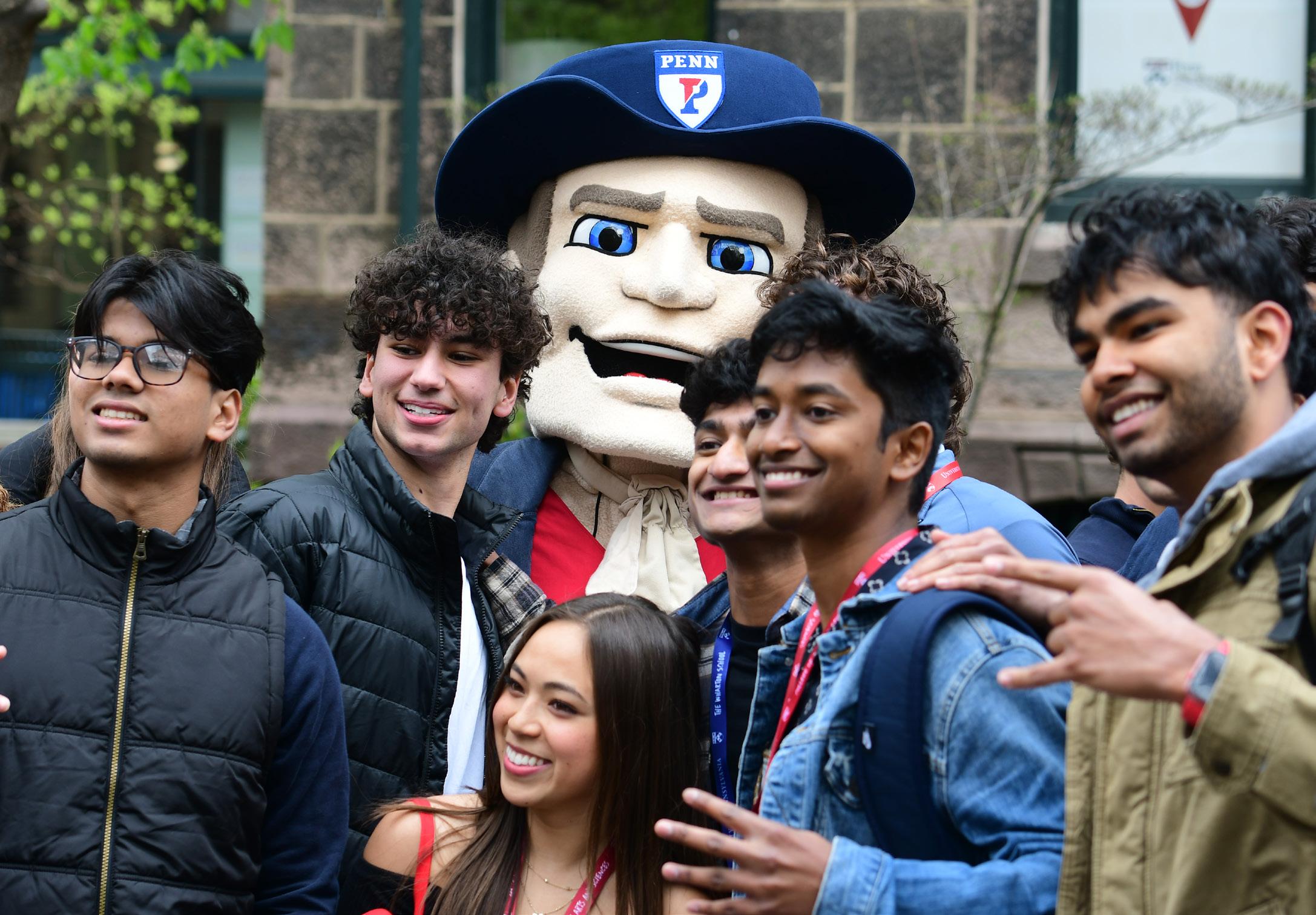


April 10, 2025






April 10, 2025


To the admitted students of the Penn Class of 2029, First off, congratulations! You made it. You’ve spent years working towards this moment, and now, you get to celebrate it. Cherish it, you deserve it.
I remember the day I got into Penn. I had just spent a long day at school, followed by a six-hour shift working at my local grocery store. I wanted to get the college application cycle over with. I can’t describe what I was feeling in the exact moment I saw confetti fall from the
edges of my acceptance letter, but I distinctly recall the excitement that permeated from within me for the next few days.
Flashback to almost three years ago, in April 2022, when I visited Penn’s campus for Quaker Days. From the tours of campus to the smiles of students, I came back with the perception that Penn was like Disneyland. Students were pretty happy, there were countless clubs to join, and it felt like everyone was living their best lives and getting what


they had wanted. After all, that’s what my 18-year-old self had been painted a picture of. College was the finish line where everything would fall into place.
But I was wrong. The moment New Student Orientation was over, the hypercompetitive club application process began. I tossed in many applications: one to Penn Mock Trial, another three to


Weekend, Ivy League athletics, and all the Fall Semester milestones ahead

Intercol, UPMUNC, and ILMUNC, and a whole bunch of other organizations that seemed remotely interesting to me. The result, you may ask? Two acceptances and nine rejections (I’m guessing you can name one of the acceptances). That’s a success rate of just 18%.
It wasn’t just the clubs though, Penn’s preprofessional environment was incredibly challenging to navigate. From landing internships to networking, there was just so much that I had absolutely no idea how to do — and, at times, it felt like everyone around me was five steps ahead.
I’ve gotten rejected from countless summer internships, research positions, and student organizations — even as recently as a few weeks ago.
You might see where I’m going with this. I’d like to offer you a piece of advice that might seem counterintuitive at the moment: Don’t just embrace your successes — embrace rejection as well.
The truth is simple (though I admit it took time to realize). We are all a bunch of young adults beginning to make sense of things. No one has it all figured out. Everyone at Penn has a unique journey in getting to this place,
while they’re here, and after they leave. The shortfalls and disappointments are all part of the journey. They’re tough, but they’ve also been the moments that pushed me to reflect and grow the most. In some cases, they have also helped me figure out what truly matters to me and have led me to discovering opportunities that I would never have found otherwise.
So, as you continue your journey at Penn or elsewhere, it’s important to remind yourself to leave some room for uncertainty. Celebrate those wins — both big and small — but also don’t let the disappointments define or discourage you. You belong at Penn, you’ve earned it, and there’s no one “set” path to take.
Well, except maybe the path to class. See you on Locust (I’m the one with a copy of The Daily Pennsylvanian on hand).
ABHIRAM JUVVADI is a College and Wharton junior studying history and finance from Morrisville, N.C. He is the president of the 141st Board of The Daily Pennsylvanian, Inc. Previously, he served as the Photo Editor on the 140th Board. His email is abhiram@ sas.upenn.edu.
Penn reinstates standardized testing requirement for 2025-26 admissions cycle
Penn to raise tuition by 3.7% for 2025-26 academic year, expand financial aid
Penn announces early decision results for Class of 2029 amid historic increase in applications
Penn releases regular decision results for Class of 2029 after receiving 72,000 applications
Five classes to lighten your fall 2025 schedule
Diana Robertson to step down as vice dean of Wharton Undergraduate Division
Wharton announces new major, concentration in artificial intelligence
Five Penn professors everyone should know
From the weight room to the lecture hall: How Penn athletes schedule their classes





College admissions content Everything new at Penn Opportunities for high schoolers
Admitted student profiles
College data resources
Internship/research program databases


After four years of test-optional admissions policies, the University announced that prospective students applying to Penn in fall 2026 will be required to submit either SAT or ACT scores as part of their application.
WILLIAM GRANTLAND Staff Reporter

Penn reinstated the standardized testing requirement for all undergraduate applicants on Feb. 14 for the 2025-26 admissions cycle.
An announcement from the University stated that prospective students applying for admission to Penn in fall 2026 will be required to submit either SAT or ACT scores. Applicants who face “hardship in accessing testing” may submit a testing waiver as part of their application, according to the announcement.
A request for comment was left with a University spokesperson.
Penn implemented a testoptional policy during the 2020-21 application cycle after the COVID-19 pandemic closed standardized testing sites. The policy has since been extended every year, with Penn Admissions attributing the decision to the “continued effects of the pandemic” and the need to ensure its office can “responsibly review the role of the test-optional practice.”
“Since then, the University has committed to reassessing this policy each year to determine whether and when it would be appropriate to reinstate the requirement,” the recent
announcement stated.
According to Penn Admissions, the reinstatement of the requirement “aims to remove uncertainty” for applicants deciding whether to submit scores. Penn will continue “considering a student’s school-based academic record on its own merit,” with SAT and ACT scores “as part of Admission’s broad and comprehensive assessment.”
“[T]esting complements a student’s existing accomplishments and can offer additional relevant information in our comprehensive and holistic admission process,” the statement read.
The shift comes as other Ivy League universities — including Dartmouth College, Harvard University, Cornell University, and Brown University — have reinstated standardized testing requirements for the 2025-26 admissions cycle after years of maintaining test-optional policies.
Yale University also reinstated standardized testing requirements but has moved to a “test-flexible” policy, allowing applicants to submit Advanced Placement or International Baccalaureate test scores in lieu of the SAT or ACT.
BY
Test-optional policies remain in place at Princeton University and Columbia University. Previous test-optional policies were correlated with a significant increase in applications. Penn’s Class of 2025 — the first to apply under the testoptional policy — broke the record for the largest application pool in the University’s history. The Class of 2028 received a record 65,230 applications, which was over 10% higher than the number of applicants to the Class of 2027.
At a University Board of Trustees meeting Thursday, administrators announced that tuition will increase from $60,920 to $63,204 next academic year.
AYANA CHARI Staff Reporter

The University Board of Trustees voted to approve a 3.7% undergraduate tuition increase for the 2025-26 academic year alongside an increase in the undergraduate financial aid budget to a record $328 million.
At a Board of Trustees meeting on Thursday, administrators announced that tuition will increase
from $60,920 to $63,204, fees from $7,766 to $8,032, and room and board from $19,174 to $19,876 next academic year. This year’s increase to the financial aid budget comes after Penn announced a new financial aid initiative titled “The Quaker Commitment” in November of 2024 that aims to improve support for
middle-income families.
Penn will no longer consider the value of the primary family home among assets in determining financial aid eligibility and will raise the income threshold for families eligible to receive full tuition scholarships from $140,000 to $200,000 with typical assets. The
new policy — which goes into effect at the start of the 2025-26 academic year — will also increase financial aid packages and guarantee full tuition scholarships to a greater number of students.
“The Quaker Commitment is a bold move that makes a Penn education more financially inclusive for middle and lower-
income families, while reinforcing the University’s reputation as a leader in fostering greater access to a Penn education,” Interim Penn President Larry Jameson wrote in a statement.
The tuition increase comes as Penn faces financial uncertainty following numerous proposed federal funding cuts that could cost
In recent weeks, administrators from the School of Arts and Sciences and the Perelman School of Medicine cited funding losses as they instructed faculty to reduce graduate program admissions rates by around one-third for the upcoming academic year.
At the meeting, “federal government policy changes” was listed as a key “issue” affecting the parameters.
Accompanying the tuition rise is a 6.4% increase in the undergraduate financial aid budget. Approximately 46% of undergraduates received financial aid grants for the 2023-24 academic year, averaging about $66,222 in funding according to Penn Admissions. The percentage of Pell Grant recipients among undergraduates also increased to a new high of 21%.
At the Thursday meeting,



Mark Dingfield said that Penn receives 6% of its undergraduate need-based funding from the federal government through Pell Grants.
“That’s a really critical source of funding for our undergraduate need program, and as we think about potential federal risks to our institution, that’s what we are most focused on, because of the direct impact on our students’ ability to have financial aid,” Dingfield said.
The tuition increase is on par with those of other Ivy League universities that have announced their 2025-26 academic costs.
Yale University’s tuition and costs will increase by just under 4%, and Brown University’s tuition and fees will increase by 4.85%.





Over 9,500 students applied to Penn through the Early Decision Program — an increase from last year’s total of over 8,500 applications — according to the University announcement.
VIVI SANKAR Senior Reporter

Penn announced early decision admissions for the Class of 2029, admitting nearly half of the incoming class in another recordbreaking application cycle.
Over 9,500 students applied to Penn through the Early Decision Program — an increase from last year’s total of over 8,500 applications — according to the University's announcement. The results were announced on Dec. 19 at 7 p.m.
Penn did not disclose the acceptance rate for Early Decision applicants, continuing its decision to withhold detailed admissions statistics.
“We are thrilled to wel-
come our newest Quakers, applaud their many accomplishments, and eagerly anticipate the arrival of the rest of their classmates in the spring. Hurrah, hurrah for the Penn Class of 2029!”
Vice Provost and Dean of Admissions Whitney Soule wrote in the announcement.
These admissions results come exactly one month after Penn announced a major financial aid expansion for the 2025-26 academic year.
The expansion aims to increase access to financial aid by raising the income threshold for fulltuition scholarships from $140,000 to $200,000 for
families with typical assets. Additionally, it will exclude the primary family home as an asset in financial aid calculations.
Following the June 2023 United States Supreme Court decision to overturn affirmative action in college admissions, Penn saw a drop in underrepresented students in its admitted classes.
In a statement to The Daily Pennsylvanian in response to the Class of 2028’s demographic data, Soule suggested that Penn would assess and adapt its practices to comply with the law and reaffirmed the University’s unwavering
commitment to diversity as a cornerstone of the Penn educational experience.
The decline in the number of students from underrepresented backgrounds aligns with similar trends observed at peer institutions, including Harvard University, Brown University, and the Massachusetts Institute of Technology.
At the University Board of Trustees spring full-board meeting earlier this year, Soule shared that 3,508 students were admitted to the Class of 2028 out of 65,236 applicants, marking the University’s most selective admissions cycle on record.
The 2024-25 application
process for Penn remains test-optional despite several peer institutions recently reinstating their standardized testing requirements. Penn’s test-optional policy was first implemented during the 2020-21 admissions cycle due to the COVID-19 pandemic.
Students who wish to apply to the University through the regular decision path have until Jan. 5, 2025 to submit their application. Regular decision results are expected to be announced in the spring.




Check out the best places, Penn clubs, and more, as voted on by Penn students








Over 72,000 students applied to Penn this year, marking an increase from last year’s applicant pool of over 65,000.
DIEMMY DANG Staff Reporter

Penn announced regular decision results for the Class of 2029 in another historic application cycle.
Over 72,000 students applied to Penn this year, marking an increase from last year’s applicant pool of over 65,000. Results were released to students at 7 p.m. on March 27.
According to a press release from Penn Admissions, the Class of 2029 includes students from over 100 countries and all 50 states. The University chose not to immediately share further demographic data about accepted students.
Penn also did not share its acceptance rate, continu-
ing a decision to withhold admissions data during the regular decision admissions cycle.
“What stands out most about this class?” Vice Provost and Dean of Admissions Whitney Soule wrote in the announcement.
“Their boundless curiosity, enthusiasm for making our world more sustainable, and commitment to making a positive impact.”
The announcement comes after recent executive orders from 1968 Wharton graduate and President Donald Trump have posed what Penn President Larry Jameson called an “existential threat” to the
University.
Following a proposed $240 million funding cut from the National Institutes of Health, Penn has reduced admissions across its graduate programs. On March 19, the Trump administration announced a $175 million freeze in federal funding to Penn, citing Penn’s “policies forcing women to compete with men in sports.”
This year marks the second full application cycle in which Penn has not been able to consider race in its admissions decisions. After a 2023 ruling from the United States Supreme Court declared race-conscious admissions
unconstitutional, Penn’s Class of 2028 saw a decline in students from historically underrepresented races and ethnicities.
The test-optional policy that Penn first implemented during the COVID-19 pandemic was extended for the final time to applicants in this cycle.
The University has since announced that its standardized testing requirements will be reinstated for applicants in the 2025-26 admissions cycle, requiring students applying to Penn to submit their ACT or SAT scores. Several other Ivy League universities — including Dartmouth College,
Harvard University, Cornell University, Brown University, and Yale University — have also reinstated testing requirements.
This year’s supplemental essays continued to include the “thank-you letter” prompt introduced during the 2022-23 application cycle.
“Each of these students embodies the spirit of Penn: a dynamic blend of intellectual curiosity, determination, and joy. We can’t wait to see them bring their talents to campus this fall,” Soule wrote.
GEORGE CHANG Contributing Reporter

Ahead of advance course registration for fall 2025 opening on March 24, The Daily Pennsylvanian compiled a comprehensive list of recommended courses based on data from Penn Course Review, a course evaluation program for students created by Penn Labs. Each class comes with positive reviews and a difficulty rating of less than 2.1.
CIMS 1004: World Film History
World Film History — taught by either Meta Mazaj or Anat Dan — surveys cinematic trends and movements across time and place, from German Expressionism all the way to Korean New Wave. According to Path at Penn, the course also examines how the framing of world cinema "reveals [the] gendered,
racial, ethnic, economic and political nature of transnational processes."
World Film History has an average difficulty rating of 1.76 on Penn Course Review. The class meets on Tuesday and Thursday at either 10:15am or 5:15pm, and has a required recitation section on Fridays.
CRIM 1000: Criminology
As an introductory course to criminology, CRIM 1000 examines the science behind law-breaking and enforcing, as well as the institutions shaping these approaches to crime.
Meeting on Mondays and Wednesdays from 1:45 to 3:15pm, CRIM 1000 has a difficulty rating of 1.81, and also counts for the Society sector requirement in the College. Penn is also set to
debut a master’s program in applied criminology and police leadership in fall 2025. CIS 1070: Visual Culture through the Computer's Eye
This Computer and Information Science class combines visual studies with machine learning, aiming to apply data science to the analysis of visual art. Enrolled students will develop their own datasets while exploring novel computer processes. The course has a difficulty ranking of 1.30, and is co-taught by Ian Verstegen and Konstantinos Daniilidis.
Students will meet on Tuesdays and Thursdays from 1:45 to 3:15pm, and the class has a maximum enrollment of 25 students.
URBS 1060: Race & Ethnic Relations
Taught by Tukufu Zuberi, this course examines the cultural and socio-political forces of race and ethnicity in the United States, with a specific focus on immigration, residential segregation, and interracial relationships. With a difficulty rating of 1.88, Race & Ethnic Relations meets on Tuesdays and Thursdays from 1:45 to 2:44 p.m. The course counts for the College’s Cultural Diversity in the U.S. requirement and is cross-listed between the Sociology, African American Studies, Asian American Studies, and Latin American Studies departments.
PSYC 0405: Grit Lab
This Stavros Niarchos Foundation Paideia course — which has been described as an “overwhelming suc-
cess” by past sections — is designed to help students develop skills for goalsetting and achievement. In fall 2025, the class will be taught by Angela Duckworth, and structured around different experiments, including journalkeeping and passion projects. Enrollment in the course requires a submitted application by April 3.
Grit Lab is cross-listed with the Operations, Information and Decisions department, and most recently had a difficulty rating of 0.98. The course meets on Wednesdays from 3:30 to 6:30 p.m.
Advance course registration ends April 7.
Professor of Marketing Cait Lamberton — leading Wharton's undergraduate programs — effective July 1.
NICK DAUM Staff Reporter

Diana Robertson, vice dean and director of the undergraduate division of the Wharton School, will step down from her role on June 30 and be succeeded by Cait Lamberton, the Alberto I. Duran President's Distinguished Professor of Marketing.
Wharton Dean Erika James announced the leadership change in an email to the Wharton undergraduate community on April 7. Rob-
ertson, known as “VDR” by many students, has served as vice dean since 2019.
Lamberton will assume the role — leading Wharton's undergraduate programs — effective July 1.
“Prof. Robertson’s impact within the undergraduate division, and across the broader Wharton community, has been deeply felt by all and will undoubtedly continue,” James wrote in the announcement.
During her six-year tenure as vice dean, Robertson focused her efforts on student wellness and community building. She introduced initiatives like free access to the Headspace mental health app and Dolphin Tank, a student pitch competition for wellnessfocused projects. Robertson also led the Connections@ Wharton task force, which aimed to strengthen relationships across the school
and foster connections among Wharton students.
Robertson has been honored with the Lindback Award for Distinguished Teaching and will remain a professor in the Legal Studies and Business Ethics Department, according to the email from James.
Lamberton joined Wharton in 2019 as the Alberto I. Duran President's Distinguished Professor for marketing. Her research focuses
on consumer behavior, including how people respond to retail environments, technology, and emotional dynamics. She has received multiple Wharton Teaching Excellence awards and has been named a Penn and Wharton Fellow.
“She will be a tremendous asset to the Undergraduate Division,” James wrote in the announcement.
The new AI program will be jointly administered by the Statistics and Data Science Department and the Operations, Information and Decisions Department with support from the Wharton AI & Analytics Initiative.
GABRIEL HUANG Senior Reporter

The Wharton School announced Wednesday that it will begin offering a new undergraduate concentration and MBA major titled "Artificial Intelligence for Business" this fall.
The addition of the concentration and major was announced by Wharton Dean Erika James in an April 2 press release. The new AI program will be jointly administered by the Statistics and Data Science Department and the Operations, Information and Decisions Department with support from the Wharton AI & Analytics Initiative.
“At Wharton, we are simultaneously focused on harnessing AI’s transforma-
tive potential while also understanding and addressing its risks," James wrote. "Artificial Intelligence for Business represents a bold step forward in our mission."
Students will be able to declare this concentration or major starting in the Fall.
As part of the program, students will be required to complete four credits in areas related to the concentration or major. This includes two credits in the “Foundations of AI in Business” and “Impact and Ethical Implications of AI in Business” categories. A list of currently approved courses is available on the undergraduate concentra-
tion and the MBA major website. Currently approved classes cover a variety of topics including applied machine learning, analytics, and behavioral sciences.
Additionally, all students will be required to take “STAT 4230/7230: Applied Machine Learning in Business” and “LGST 2420/6420: Big Data, Big Responsibilities: Toward Accountable Artificial Intelligence.” The press release described the latter as a course “dedicated to advancing the responsible development and governance of AI technologies.”
Operations, Information and Decisions associate professor Prasanna Tambe
Science professor Giles Hooker will advise both the undergraduate and graduate program. In a statement to The Daily Pennsylvanian, Tambe described the program as “an exciting step toward preparing future leaders for the rapidly transforming world of AIdriven industry.”
“As AI continues to revolutionize decision-making, it’s essential for our graduates — tomorrow’s managers — to understand and leverage its power to lead with confidence,” Tambe wrote.
Hooker wrote to the DP that the program will prepare students to “leverage
this rapidly evolving technology and shape the way it will transform business and society.”
“These programs put students at the leading edge of the application of AI and we are enormously excited to support them,” Hooker wrote.
The launch of the program comes as Penn has increased its commitment to AI-related initiatives. Last year, Penn became the first Ivy League school to offer a bachelor's degree in artificial intelligence. This past week, Penn AI hosted its official launch event at Amy Gutmann Hall.
Penn employs talented professors who are experts in a variety of fields including psychology, business, and politics. Here are five of the most well-known Penn professors whose influence spans well beyond their classrooms.
DARIA KNURENKO Staff Reporter

Kristen R. Ghodsee
Kristen R. Ghodsee is a professor and chair of Russian and East European Studies at Penn. Her research focuses on the lived experiences of socialism and post-socialism and examines the gendered effects of the transition from communism to capitalism, post-communist nostalgia, and the human impact of the Soviet Union’s collapse.
She is the author of 12 books, including "Why Women Have Better Sex Under Socialism," which has been translated into over 10 languages. Her recent book, "Everyday Utopia: What 2,000 Years of Bold Experiments Can Teach Us About the Good Life," explores historical and cultural examples of community-building, offering practical insights for creating more equitable societies.
At Penn, Ghodsee teaches a class called "Sex and Socialism" and hosts a podcast where she reads and discusses the works of Alexandra Kollontai, a Ukrainian-Finnish socialist women's activist.

Amy Gutmann

Adam Grant
Adam Grant, the Saul P. Steinberg Professor of Management and professor of Psychology, is the youngest and most highly rated professor at The Wharton School. As a leading expert in organizational psychology, his research focuses on motivation, meaning, generosity, and creativity.
Grant’s books, including “Hidden Potential: The Science of Achieving Greater Things,” “Think Again: The Power of Knowing What You Don't Know,” and “Give and Take,” are New York Times bestsellers.
He hosts a TED original podcast WorkLife, and his TED talks have been viewed over 10 million times.
Grant’s clients include Google, the NBA, and the Gates Foundation. He has been recognized as one of the world’s most influential management thinkers and named in Fortune’s 40 Under 40.
Amy Gutmann, the longest-serving University president, returned to Penn in 2024 as the Christopher H. Browne Distinguished Professor of Political Science and Professor of Communication at the Annenberg School for Communication.
Gutmann served as the University’s president from 2004 to 2022. Her 18-year presidency is widely considered one of the most transformative in Penn’s history. After her tenure, she became the first woman to serve as the United States Ambassador to Germany. Gutmann’s scholarship focuses on democracy and education, as well as the processes of discussion, negotiation, and diplomacy. She is currently on leave but will resume teaching next academic year.
Gutmann is an author and editor of 17 books, including "Why deliberative democracy?", "The Spirit of Compromise," and "Everybody Wants to Go to Heaven but Nobody Wants to Die: Bioethics and the Transformation of Health Care in America." In 2018, she was named one of the “World’s 50 Greatest Leaders” by Fortune for her work promoting affordable education and healthcare, life-saving innovations, global collaboration, and public-private partnerships.

Ed Rendell
1965 College graduate and former Pennsylvania Governor Ed Rendell taught "Who Gets Elected and Why? The Science of Politics” during the fall 2024 semester. He served as the mayor of Philadelphia from 1992 to 2000 and was he was praised for making significant improvements to the city’s services and budget management during his tenure. Rendell also chaired the Democratic National Committee during the 2000 presidential election. Rendell served as Pennsylvania's governor from 2003 to 2011, where his administration focused on education, infrastructure, and economic development. He remains active in political discourse and now shares his expertise with students as a lecturer at Penn.

Angela Duckworth
Angela Duckworth is the Rosa Lee and Egbert Chang Professor and faculty co-director of the Penn-Wharton Behavior Change for Good Initiative. As a 2013 MacArthur Fellow, she has advised the World Bank, NBA and NFL teams, and Fortune 500 CEOs. Her 2016 novel, "Grit: The Power of Passion and Perseverance," is a New York Times bestseller. At Penn, she teaches the popular SNF Paideia Designated course “PSYC 0405 Grit Lab: Fostering Passion and Perseverance in Ourselves and Others.” Duckworth is also a cofounder of Character Lab, a nonprofit that promotes scientific advances that help children thrive.


G Your guide to course registration for Fall ‘25

A
deep dive into the schedules of Penn's Division I student-athletes.
HANNAH CHANG Sports Reporter

5 AM. 5:15 AM. 5:50 AM.
Three morning alarms ring.
Junior swimmer Emma Stolberg, senior wide receiver Jared Richardson, and sophomore heavyweight rower RJ Sylak wake up.
Stolberg makes her bed and cleans her room before heading to Van Pelt to do homework. Usually around this time, the swimming team goes to practice, but because of Sheerr Pool being under renovation this school year, the team has had to practice at Drexel. This year’s practice schedule looks different,
so Stolberg can have a bit more time to study in the morning.
Richardson takes a shower and eats four hard-boiled eggs and fruit for breakfast.
Sylak gets ready for the 15-30 minute bus ride to Boathouse Row, several miles away along the Schuylkill River. It’s where the team practices because the boats, or shells, are housed there. Today, he might bike there.
6:30 AM.
Sylak leaves for practice.
6:50 AM
Richardson leaves for the football team’s first meeting.
8:50 AM.
Stolberg heads to swim practice at the Drexel pool.
10:50 AM.
Stolberg and Richardson finish their respective morning practices. Stolberg gets ready for classes. Richardson takes a muchneeded nap for an hour.
“After football, I’m dead tired,” he says. “I take a nap every day. … I don’t think there’s more than, I’d say, like 15 days where in season and out of season, where I didn’t take a nap.”
From noon, the three athletes’ schedules diverge. Depending on the day, Stolberg and Sylak might have afternoon practices for another 2 hours. Depending
on the semester and if they have swim meets, rowing races (called regattas), or football games, their practice schedules change, and their weekends may be taken up by travel.
With chunks of their day dedicated to their sport, classes have to fit in the time left over.
The football team is not allowed to take classes before 12 PM. On days when the rowing team practices morning and afternoon, there’s really only time for 10:15 AM, 12 PM, or evening classes for Sylak. Sometimes, swimmers will have to go straight to class after practice. Dripping wet,
hair frozen in the winter, smelling of chlorine, and somehow having to concentrate on Math 1400.
“Swimmers … may be the most productive people you have ever met,” Stolberg said, “because the scheduling — it sucks.”
And it does “suck” to have to pass on classes because of sports.
Stolberg, instead of taking Spanish in high school to fulfill her language requirement, had to take Malagasy, which was held twice a week instead of three. Many athletes are in the class for the same reason she was. It just fit better into their schedules. (cont. on next page)

Sylak had to postpone a major requirement class — Wharton’s OIDD 2200 — to next semester so he could miss only one practice every week instead of two.
For rowing, missing a practice can mess up the whole team. In a sport where groups of 8 or 4 athletes race together, the men have to form a unity with one another, so the groups in each boat are kept relatively consistent.
“If you’re gone because you have class,” Sylak said, “that puts a big detriment on the boat and on the team as a whole.”
An early bird, Richardson would much rather take 8:30s and 10:15s to get classes done early, but he can’t because of football practice in the mornings.
“I don’t have the luxury to do that,” he said. In between and after
classes, they work on assignments whenever they can, literally in the few hours they have left in the day.
“You just get it done when you get it done,” Sylak said.
Stolberg barely has time to eat, often having things like egg bites, protein bars, and cheese sticks to hold her over until dinner, when sometimes she feels like she’s a “massive football player eating anything in sight.”
When seeing her nonstudent-athlete roommate cook dinner, Stolberg remembered that it was normal to be able to cook dinner.
“I would love to have time to cook a meal,” Stolberg said.
Sylak also acknowledges that athletes “make a lot of sacrifices, you know, beyond sort of the normal weekend stuff.”
future. Stolberg is part of a sorority, and though she isn’t as involved as she would like because of time constraints, she still does hang out with her bigs. Sylak is involved in a myriad of clubs, including but not limited to Wharton Undergraduates in Public Policy and Wharton Undergraduate Aerospace Club.
Student-athletes have to use their time wisely, and that means making different decisions than others around them. Stolberg attends classes even when she’s sick because all of her excused absences have to be used for swim meets. Both Sylak and Richardson are not involved in greek life on campus, going to bed earlier than the average college student.

to write, produce and perform original comedy
We’re looking for talented and dedicated undergraduate students to join all four sections of the Club:
CAST: Actors, Writers, singers, dancers, comedians.
BAND: Instrumentalists. Drive the beat of our productions!
STAGE CREW: Tech wizards, builders, designers.
BUSINESS STAFF: Marketers, managers, finance gurus.
AUDITIONS & INTERVIEWS are EARLY this fall semester!






Don’t miss your chance to join the camaraderie and chaos. information at:


Audition information at: maskandwig.com/join
In another life, he would’ve considered studying abroad for a semester like some of his friends. But, as a rower, he has to stay on campus even over spring break to practice and compete.
For Richardson, who hopes to play football professionally, there is nothing else that could compete for his time outside of classes and football. He understands that everyone, even among his teammates, has different priorities, but for someone who wants to take his passion to the highest level, Richardson keeps himself on a strict schedule.
“My fraternity is the football team,” he said, “I obsess over football.”
That doesn’t mean he, or any other student-athlete, doesn’t have a life outside of their sports.
“It’s really funny,” Sylak said, “Because there will be things happening in a group chat for a class project, and you’ll just wake up to 30 unread messages, and you’re trying to piece your way through what happened after you went to sleep.”
There are also conflicts in their personal lives or breaks with athletic commitments beyond class scheduling. Stolberg’s younger sister half-jokingly asked her to “quit swimming,” so they could have time to call. Stolberg adds to that, saying she consistently feels like she’s running around with her head slightly cut off. Sylak has to compete even during finals and into the beginning of June. Richardson has to be on campus for parts of the summer for 6 AM workouts — for which he wakes up at 4:30 AM — and it’s worth it. But these small sacrifices are worth it for their sports.
Want to see what we’re all about? Experience the energy, the music, and the laughs live at our can’t-miss FREE SHOW with Bloomers this fall!
Want to see what we’re all about? Experience the energy, the music, and the laughs live at our can’t-miss FREE SHOW with Bloomers in September! @maskandwig
Richardson is doing his capstone project this semester, studying slavery and the conditions of the transatlantic slave ships. He hopes to go into healthcare administration in the
“It’s a lot, but I signed up. I chose this life and decided to be a college football player, and I’m gonna live with it,” Richardson said. 8:30 PM. 9:30 PM. Lights out.
With last week’s Ivy Day admissions decision release, over 72,000 hopeful Quakers anxiously logged into their admissions portals, bracing for the dreaded “status update.” For around 68,000 of them — roughly 95% — the news didn’t include a spot in the Class of 2029.
While the dean of admissions had to “regretfully inform” these applicants of their decision, the University Board of Trustees will be celebrating Penn’s ultraselectivity a few months from now. That’s because, for Penn and our peer institutions, the more brilliant students we reject, the more desirable we appear.
For Penn, exclusivity is excellence. That doesn’t make any sense.
As our University Values so eloquently highlight, the ultimate purpose of higher education is to advance “opportunity toward a better future for all.” Universities — especially those as resource-rich as Penn — are meant to be engines of social change, opening paths to more opportunities and shaping promising leaders. It’s ironic then, that elite colleges pride themselves on shutting out as many people as possible, effectively limiting their social impact.
The reality is the vast majority of applicants to schools like Penn are more than qualified to succeed in a rigorous academic environment. That means we’re closing our doors to tens of thousands of hardworking students who could fully take advantage of a Penn education to change their lives and the lives of those around them. In that sense, our prized 5% acceptance rate is really an indication

of our failure to be a maximally impactful institution. Moreover, Penn admissions officers rendering decisions by splitting hairs over minute differences between accomplished applicants doesn’t truly strengthen our student body — in many ways, this weakens it. The New York Times found that more Penn students came from the top 1% than the entire bottom 60%. For Penn’s Class of 2028, 14% of admits were legacy students. In our relentless focus on gatekeeping admissions, Penn’s limited seats are disproportionately filled by the advantaged.
But it doesn’t have to be this way.
Say Penn decided to increase the size of its incoming class. Without sacrificing academic excellence,
we could better fulfill our mission of expanding access to opportunity by instructing more highly deserving students who would use their education for the better. By creating more spots, Penn could welcome a wider array of perspectives, fostering a more balanced campus enriched by diverse backgrounds rather than those just clustered at the top of the socioeconomic ladder.
Now, I’m not here to argue the logistics of hiring more staff or constructing another college house to support a larger class size. However, such expansions are certainly not unheard of. In recent years, multiple highly selective schools, including Rice University, Yale University, and Princeton University, have all taken the initiative to build
new housing in order to grow their undergraduate population, citing a focus on expanding access and diversity.
New dorms are also not the only potential path forward — education researchers have proposed alternatives such as expanding hybrid learning models and establishing satellite campuses to reach more students. After all, if one can get an MBA from Wharton San Francisco, why can’t Penn do the same for undergraduates? We have a $22.3 billion endowment to make it happen. And sure, Penn already enrolls more students than a lot of its peers — which is fantastic! But that doesn’t excuse us from actively working to uphold the values of higher education.
Ultimately, as powerful
as these changes could be, they’re dismissed as unrealistic over a single word: prestige. An Ivy League education is no different from that blue Goyard bag you see on Locust Walk: Its value is found in a brand name, capturing allure through rarity. Ivy Day is how Penn sustains this “status.” But instead of staking our reputation on this year’s 68,000 letters not offering admission, we could define success by a much more meaningful metric: the number of accomplished students Penn truly supports.
JESSE VAN DOREN is a College first year studying political science and earth and environmental science from Baltimore. His email is jessevd@sas.upenn. edu.
Dear Class of 2029, First, congratulations. You’ve done something extraordinary — not just because the numbers say so, and not because Ivy League admissions are edging into Nobel Prize-level territory, but because I know exactly what it feels like to get here. The sleepless nights over that one extra problem set. The ACT grammar-induced existential meltdowns.
The months of waiting and wondering, all culminating in one looming question: Is this the right place for me?
When I got into Penn, I didn’t cry. I didn’t scream. I just sat there, wide awake at 5 a.m., clutching my childhood pillow, trying to process it. After being deferred, I’d buried my Penn merch and made peace with the possibility of rejection. And then, like every ex whose photos you had just deleted, Penn came back.
Maybe that’s where you are now. Texting friends, deep-diving into Reddit threads, and stalking the DP. Waiting for a sign. I won’t pretend to have all the answers. But I can tell you this: I would choose Penn again. Every time.
Let’s get this out of the way: the stereotypes? Probably all true. We’re more than a little preprofessional. Philadelphia has its questionable moments. The weather makes no sense. And yes, someone really did organize a Luigi Mangione lookalike contest.
But there’s also so much more the stereotypes don’t capture.
Right now, I’m writing this SABS-ing (you’ll learn what that means soon) by the ARCH on a warm spring
Senior columnist Diya Choksey shares why she chose Penn and offers an insider's sneak peek for the admitted class.

afternoon. There are cherry blossoms above and music in the background. Students are handing out flyers for clubs, shows, protests — most of which I’ll forget to attend but take anyway. Because that’s the thing about Penn: It’s not just the buildings or classes. It’s the energy. The hum of movement. The constant feeling that something is happening, whether that’s Mark Cuban casually swinging by campus or the infamous Econ Scream echoing through Locust Walk. No matter how long you’re here, there’s always more to discover: a tucked away Joe’s Café I found too late, a shortcut I wish I’d known before that 8:30 a.m. lecture, a class that quietly but permanently changed the way I think. Faces on Locust Walk that
slowly became familiar then essential. For a city girl like me, Penn somehow feels like a small town (with the privilege of a skyline just 15 minutes away).
Of course, it’s not all sunshine and rainbows. Our Instagram feeds from Saint Patrick’s Day or the Super Bowl parade don’t show the all-nighter that came before. There are mornings during finals season when giving up feels dangerously close. But then, the next day comes. And somehow, you stay. You grow. You find something new to look forward to, like a late-night Kiwi run with friends or screaming your lungs out at Spring Fling.
Part of what makes Penn extraordinary is also what makes it intimidating. You’ll meet people who’ve published novels, launched
companies, and competed in the Olympics. You might never be the most impressive person in the room again. And you’ll be rejected and humbled — far too many times to count. But all of this is also exactly what pushes you. You begin to realize the ceilings you once imagined for yourself were never real. You stop seeing rejection as a mirror and start using it as a fuel to reflect and recalibrate. Slowly, comparison gives way to curiosity. Envy softens to admiration. In just two semesters, I don’t think I would’ve grown this much anywhere else.
I know elite universities are under scrutiny lately, and Penn isn’t immune. We have hard questions to answer here as we imagine the kind of institution we want to be. But I don’t believe
PHOTO BY ELLIE PIRTLE
you can hate a place into becoming better. You have to love it enough to expect more from it — and care enough to expect more from yourself inside of it.
And that’s how I feel about Penn. It’s not always easy. It’s not always fun. But it is, without question, one of the most meaningful places I’ve ever had the privilege to be.
So if you’re sitting there, undecided and uncertain, still refreshing that Reddit thread, I won’t tell you what to do. But I will say this: I would choose Penn again. One thousand times over. And I hope you give yourself the chance to experience it too.
DIYA CHOKSEY is a College first year studying cognitive science from Mumbai, India. Her email is dchoksey@sas.upenn. edu.





This Valentine’s Day, Penn Admissions delivered the ultimate love letter to future applicants: a statement announcing a return to standardized testing requirements.
While it may be a tough pill to swallow, the SAT and ACT — for all of their flaws — are invaluable tools in the college admissions process. Doing away with the test-optional policy is ultimately a win-win for the Penn admissions team and the applicant pool it reviews.
Penn’s statement centered the decision around the idea that a testing requirement removes “uncertainty for applicants” suffering from the mental gymnastics of deciding what score is worth submitting. Everyone who’s applied to college in the last few years can recall agonizing over which scores to send to which schools. As high schoolers navigate an already stressful process, test-optional admissions add on an extra load of angst.
Much of this anxiety stems from the fact that test-optional policies have created unrealistic and unhealthy expectations, as applicants aim to submit scores that fall well within the top admissions percentiles. In 2019, prior to a test-optional policy, Penn’s median SAT score was 1505; by 2023, that number jumped 45 points to 1550. As these scores keep climbing, applicants lose sight of what truly matters. Students began ditching their real passions to obsess over testing and retesting and
retesting again, all for a few extra points.
A return to test-mandatory policies is a return to testing sanity. Students will have one less burdensome decision to make, and as the data will show, they will finally be able to breathe knowing a 1600 isn’t the only ticket to an acceptance letter from Penn.
On the other side of things, Penn’s admissions officers will benefit from having an objective data point that is proven to be the strongest predictor of success in college and beyond. Without test scores, the only number admissions officers can use to measure academic success is high school GPA. That’s a pretty flimsy metric, especially in a world where standards vary wildly across the world, and almost every top applicant has near-perfect grades. In fact, students with a high school 4.0 go on to have a college GPA only 0.1 points higher, on average, than those applying with a 3.2.
Now let’s compare that to SAT and ACT scores; students with a 1600 or 36 earn a first year GPA that is, on average, 0.43 points higher than those with a 1200 or 25. Moreover, higher standardized testing scores are strongly correlated with success after college, whether that be attending an elite graduate school or working for a prestigious firm.
Of course, graduating summa cum laude or landing a return offer from McKinsey are not the only indicators of a successful

undergraduate experience. But, they do illustrate a broader point: Standardized testing scores provide meaningful insight into a student’s potential for academic and professional achievement. In Penn’s admissions process that is clouded by subjectivity, an SAT and ACT score shines as the only objective benchmark — a game-changer in the quest for consistency in an ultra-competitive and highly opaque system.
Even more importantly, the SAT and ACT’s greatest potentials lie in their ability to uplift disadvantaged Penn applicants. Yes, it’s true that low-income test takers, on average, score lower than their wealthier counterparts. But don’t you think that Penn’s highly experienced admissions team is aware of that fact? Those working in selective admissions understand that test scores reflect societal inequalities, as affluent students often have access
to test prep and private tutoring that can dramatically boost their scores. That’s why they also recognize that a modest-income, public high schooler from rural Oklahoma who scores a 1400 is far more impressive than the wealthy Trinity student from the Upper East Side with a 1580.
As has been conceded by Brown University, Cornell University, Harvard University, Yale University, Massachusetts Institute of Technology, and other elite schools, SAT and ACT scores can help admissions officers identify underresourced students with immense potential. Under Penn’s former test-optional policy, many of these students likely opted not to submit scores below the median — yet, in reality, doing so could have meaningfully improved their chances for admission. Having a test-mandatory policy will take this chance out of the question.
Standardized testing is easy to hate. Naturally, we reject the idea that our “academic potential” can be summed up in a single number — and it’s true that for all their predictive value, the SAT and ACT certainly do not show the whole picture. But they’re not supposed to. Test scores are one valuable number amongst 2,500 words from each Penn applicant and their teachers that help admissions officers understand their background, their passions, and their aspirations. In that light, the end of test-optional isn’t a radical overhaul of Penn’s admissions process but a rational step toward clarity and fairness. For that reason, going test-mandatory is a win.
JESSE VAN DOREN is a College first year studying political science and earth and environmental science from Baltimore. His email is jessevd@sas.upenn. edu.
Columnist David Tran exposes a harmful fallacy in the rhetoric against testoptional admissions and how we perpetuate it.
When Dartmouth College became the first Ivy League school to reinstate a mandatory testing admissions policy for the 2024-25 admissions process, it argued that standardized testing provided a uniform benchmark to identify students from diverse backgrounds likely to succeed. Yale University, Brown University, and Harvard University quickly followed, citing similar reasons for eliminating test-optional admissions. Now, as Penn announces a return to a test-required admissions policy for the 2025-26 cycle, it appears that opponents of test-optional admissions are finally claiming victory, declaring the end of the test-optional experiment.
It’s ironic that the debate on test-optional admissions centers around “fairness.” Even opponents acknowledge the admissions process is systemically unequal but claim that test-optional policies unintentionally harm low-income students by removing a uniform benchmark that allows them to stand out. To them, the solution is to reinstate test-required admissions. After all, standardized testing is the only objective part of the application — everyone has the chance to take the same SAT and ace it.
But have we forgotten what the SAT truly measures? Sure, the test is standardized, but what about the opportunities to take the test? This top-down approach that insinuates standardized testing as the great equalizer in the admissions process is dangerous. This rhetoric is counterproductive to addressing the
deeper roots of inequality. Test-optional policies aren’t the problem; we are. Rather than arguing that testoptional admissions favor wealthier applicants or that SAT scores reveal students truly worthy of success in college, shouldn’t we instead ask why low-income students must prove their worth in a system not built for them?
We exploit every possible advantage while they lack basic necessities. While we seek out doctors to pay off to fake an ADHD diagnosis for extra testing time on the SAT, there are low-income students with disabilities who struggle to get any medical attention. Wealthy high schools have 2.6 times more students eligible for additional time on tests compared to low-income high schools. Even medically valid diagnoses for testing accommodations are indicators of inequality — many disadvantaged students are less likely to receive diagnoses for conditions requiring accommodations, such as autism or ADHD, due to limited access to healthcare. Universities won’t be able to identify many high-achieving low-income students if they aren’t provided the accommodations to prove themselves in the first place.
But the disparity doesn’t end there. Wealthier students get multiple attempts to perfect or superscore their SAT. Low-income students only get two attempts with a College Board fee waiver, and many don’t ever bother to retake it. A 2018 study from the National Bureau of Economic Research

found that low-income SAT takers are 20.6% less likely than high-income students to retake the SAT, and 53% of SAT takers using a fee waiver on their first try do not retake the exam. The score they get will not accurately reflect their potential as a result, and many highachieving low-income students are filtered out. For a low-income student enrolled at a competitive high school, their scores appear artificially low compared to the school average, making it harder for them to stand out in college admissions. Many testing centers in suburban areas are also inaccessible to low-income students due to limited access to transportation. Only 57% of 16- to 18-yearolds in households making under $50,000 have the luxury of having a driver’s license. If they needed a ride, as many as 19% of households living below
200% of the poverty line lack access to a personal vehicle, compared to only 5% living at or above 200% of the poverty line.
There are cultural, social, and familial barriers to taking the SAT as well. Low-income adolescents are 53.3% more likely to take on caring for their siblings when their single mothers are employed, with a 66.4% chance of it becoming becoming a routine responsibility. Students in these families do not have the time and resources to take standardized tests, let alone prepare for them.
But our students do. In 2019 alone, we spent a record $1 billion on test-prep for our students because we take time and money for granted. We spend hours stressing over that four-digit score that would make or break our student’s college applications. But to a low-income applicant,
those hours might be spent worrying about food that won’t be on the table that night. The luxury of a test score that stands out to admissions officers is one that their time and money often can’t afford.
If we still want to argue that test-optional admissions are inequitable, fine. If we still want to claim that standardized testing levels the playing field, go ahead. But remember why the testoptional debate began in the first place.
DAVID TRAN is a freshman studying urban studies from Fort Worth, TX. His email is ddtran@sas.upenn.edu.

Shop Penn offers 60+ stores, restaurants, and entertainment venues right on Penn’s scenic, historic campus. Start your Penn Quakers journey with a little retail therapy, delicious meals, and fun moments at Shop Penn!
Shop Local. Shop Penn.
#SHOPPENN
@SHOPSATPENN



